Ineos Quartermaster: Tested
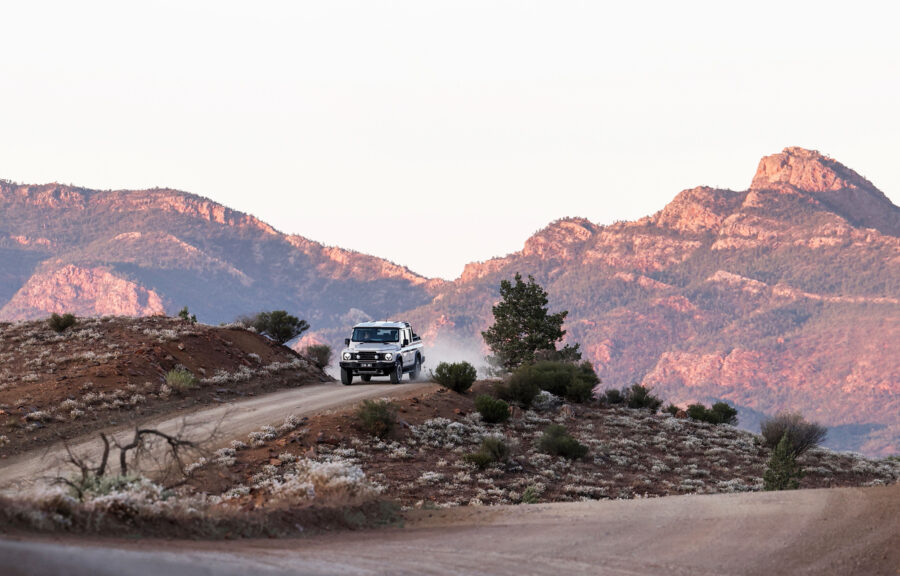
Ineos Automotive, the brand that was created in 2017 by British billionaire Sir Jim Ratcliffe, has just launched a dual-cab ute version of its Grenadier 4×4 called the Quartermaster (see What’s a Grenadier at end of this review). With rugged separate body-on-frame construction, live axles and coil spring suspension, available diff locks front and rear, and a dual-range transfer case, the Quartermaster is one of only a few vehicles to offer exceptional off-road capability straight off the showroom floor.
If you’re thinking the Grenadier has a familiar appearance, you’d be right; you don’t even have to look twice to see it resembles a pre-2016 Land Rover Defender and, in fact, in 2020 Jaguar Land Rover (JLR) filed a lawsuit against Ineos Automotive over the design of the Grenadier, claiming it was too similar to the original Land Rover Defender. But in 2021 the court ruled that while the Grenadier shared some similarities with the Defender, the design differences were significant enough to avoid infringing on JLR’s trademark.
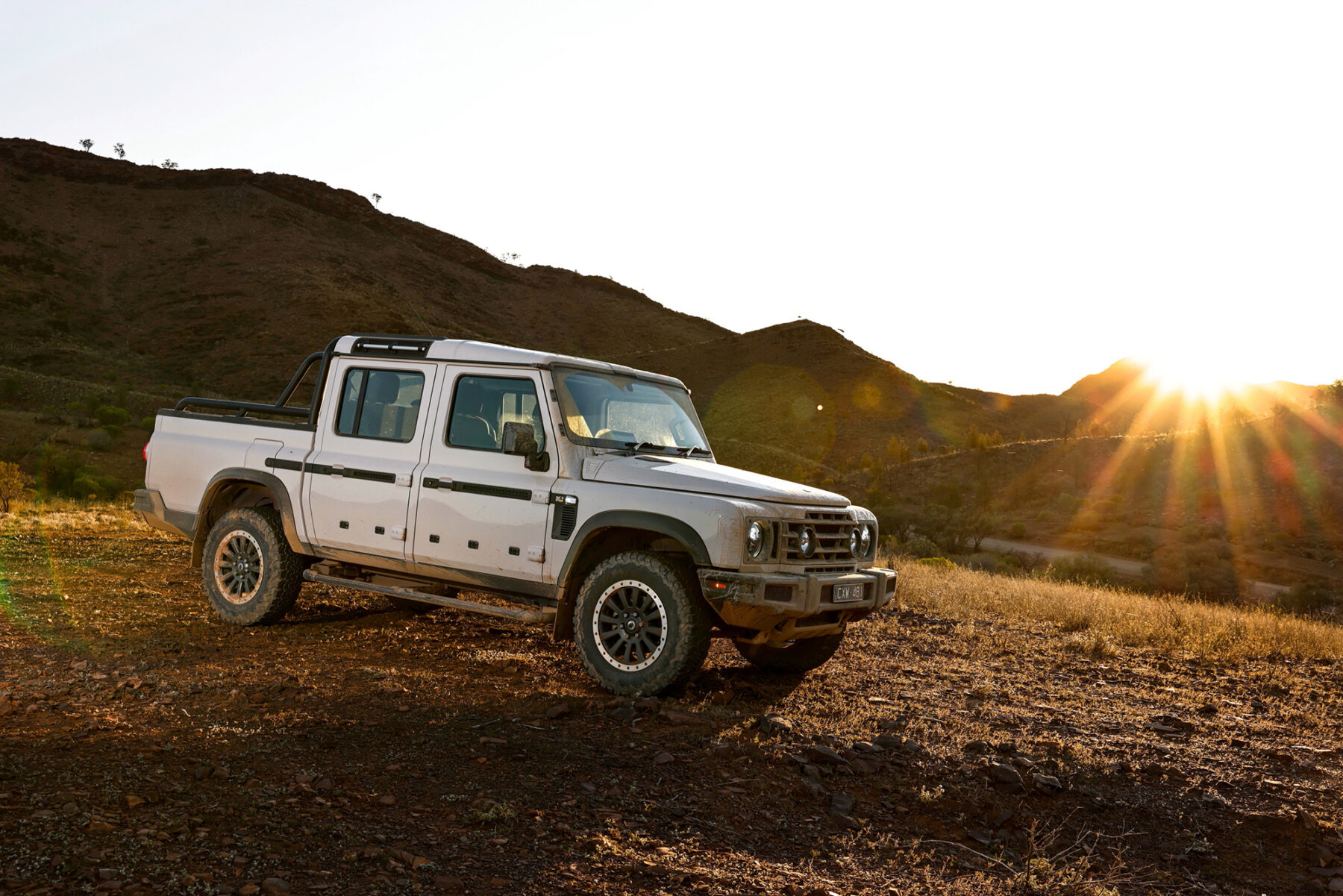
In the case of the double-cab Quartermaster ute, there is good reason for this utilitarian appearance. Short overhangs to optimise approach and departure angles for off-road capability; high ground clearance to maximise ramp-over angle and minimise the chance of grounding the vehicle in rough terrain; an upright windscreen, deep windows and short bonnet to provide a commanding driving position that aids outward visibility; and a long wheelbase (Quartermaster ute’s is 300mm longer than Grenadier wagon’s) for optimal load distribution.
All the tech in the Quartermaster
The Quartermaster is available with two BMW-sourced engine options: a 3.0-litre inline-six turbo-petrol engine producing a claimed 210kW at 4750rpm and 450Nm from 1750-4000rpm, and a 3.0-litre twin-turbo-diesel engine delivering a claimed 183kW from 3250-4200rpm and 550Nm from 1250-3000rpm. Both are tuned for torque and reliability instead of peak power, and both will find favour with off-road tourers, campers and outback adventurers thanks to the broad spread of torque they provide throughout their respective rev ranges, and their impressive refinement.

Both engine options are paired with a ZF eight-speed automatic transmission that delivers smooth, almost imperceptible shifts. Drive is delivered to the wheels via a full-time 4×4 system with a lockable centre differential, and a two-speed transfer case provides decent low-range reduction for crawling over off-road obstacles or for climbing steep tracks.
When optioned with front and rear diff locks (standard kit on the Trialmaster model variant), the Quartermaster is a formidable off-road vehicle. When the centre, front and rear differentials are locked, Quartermaster provides maximum traction on loose, slippery and uneven surfaces, minimising wheel spin and ensuring forward momentum can be maintained when crawling over tricky obstacles.
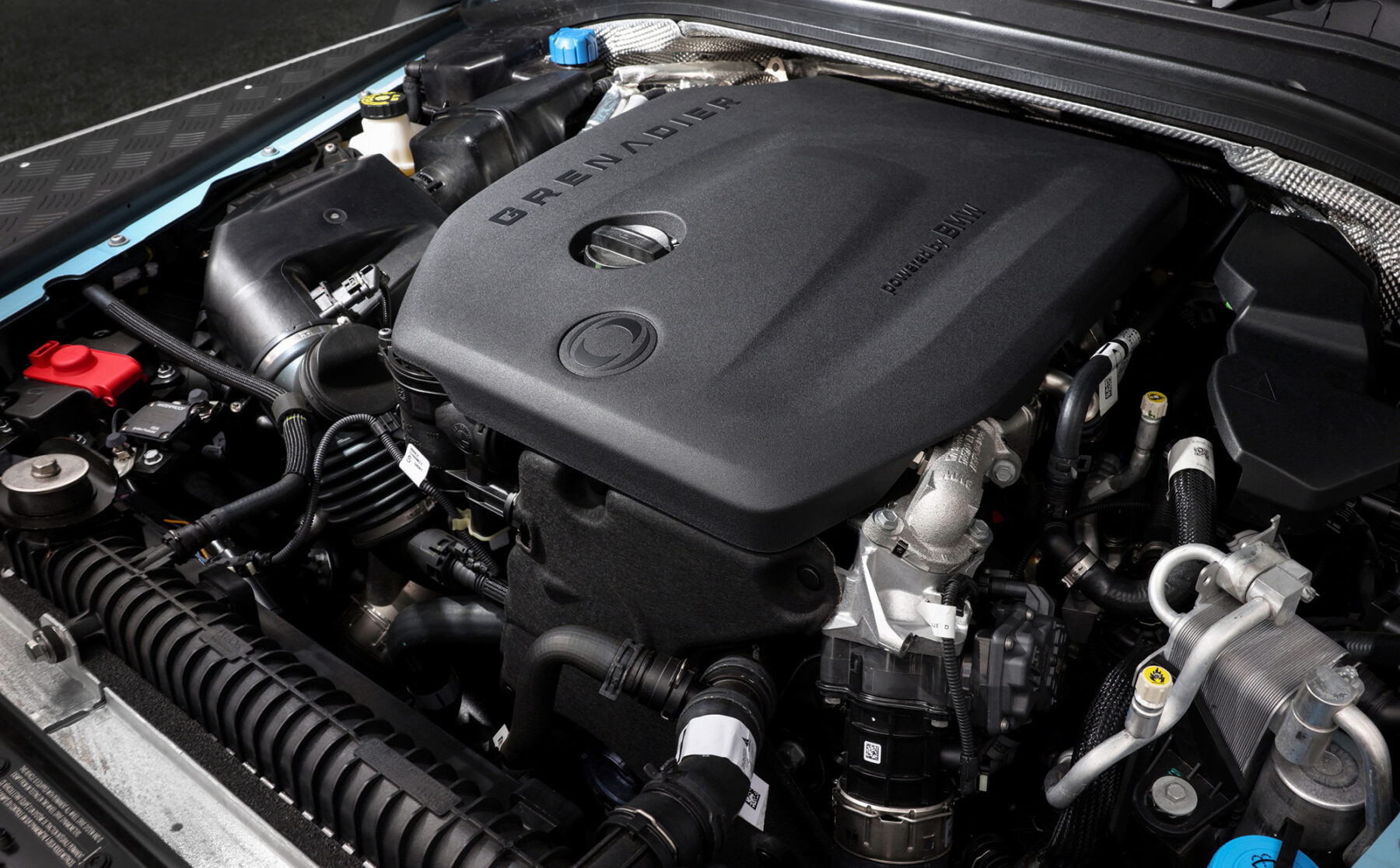
Built on a chunky ladder-frame chassis, the Quartermaster boasts a robust and time-tested design. The suspension system combines coil springs with live axles, offering a blend of durability and articulation, crucial for maintaining traction in off-road conditions.
On-road performance
The Quartermaster is surprisingly refined on the road for what many will see as a utilitarian vehicle, and this can no doubt be partially attributed to its separate-chassis construction, which provides a level of isolation between the chassis and the cabin. But more than that, both the petrol and the diesel engines are smooth and refined, with good noise suppression between the engine bay and the cabin. If you drive with the window down there’s an audible induction howl from the raised air intake under heavy loads, but it’s not unpleasant.
Performance-wise, the petrol engine provides slightly more acceleration than the diesel engine, but there’s not really a lot in it. Over the two-day test drive – which included sealed highways, dirt roads and a smattering of low-range off-road driving – the petrol Quartermaster averaged 14.4L/100km while the diesel variant fared better at 11.7L/100km. Again, I’d venture to suggest that under load, when towing, or when driving in soft off-road terrain such as on sand, the fuel consumption difference would be more noticeable, with the diesel offering better economy and therefore a longer touring range.

Both Quartermaster variants run a 90L fuel tank, so you should be able to see 600km between refills in the petrol version and 750km in the diesel. Ineos says it has been working closely with local suppliers and that a Brown Davis 68L auxiliary fuel tank is available to suit the Quartermaster, bringing total fuel capacity up to 158L. And for those wanting to go on extended remote-area adventures, there’s a massive 168L auxiliary tank available that brings total fuel capacity up to 285L. With the latter, a diesel Quartermaster could conceivably travel 2400km between refills!
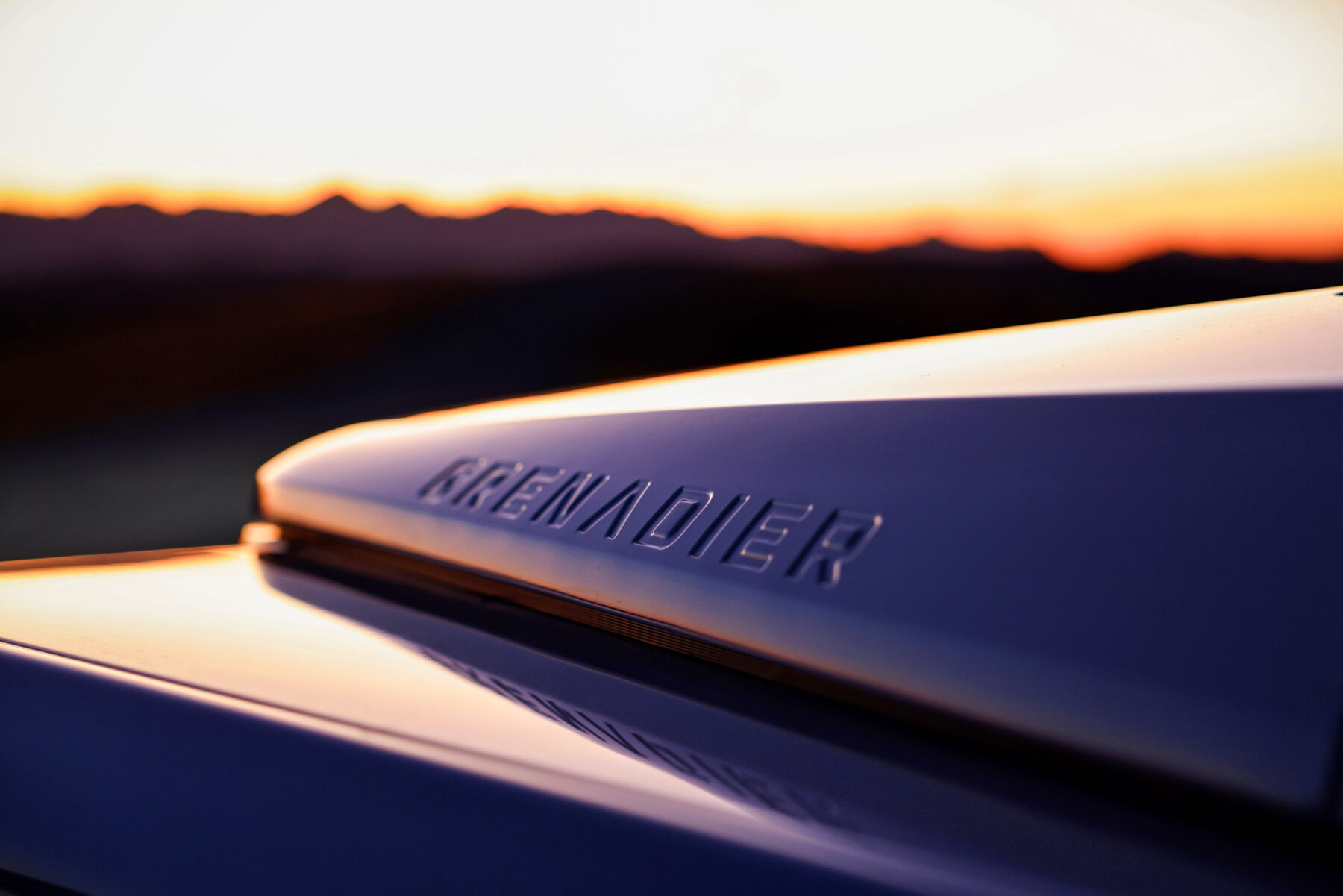
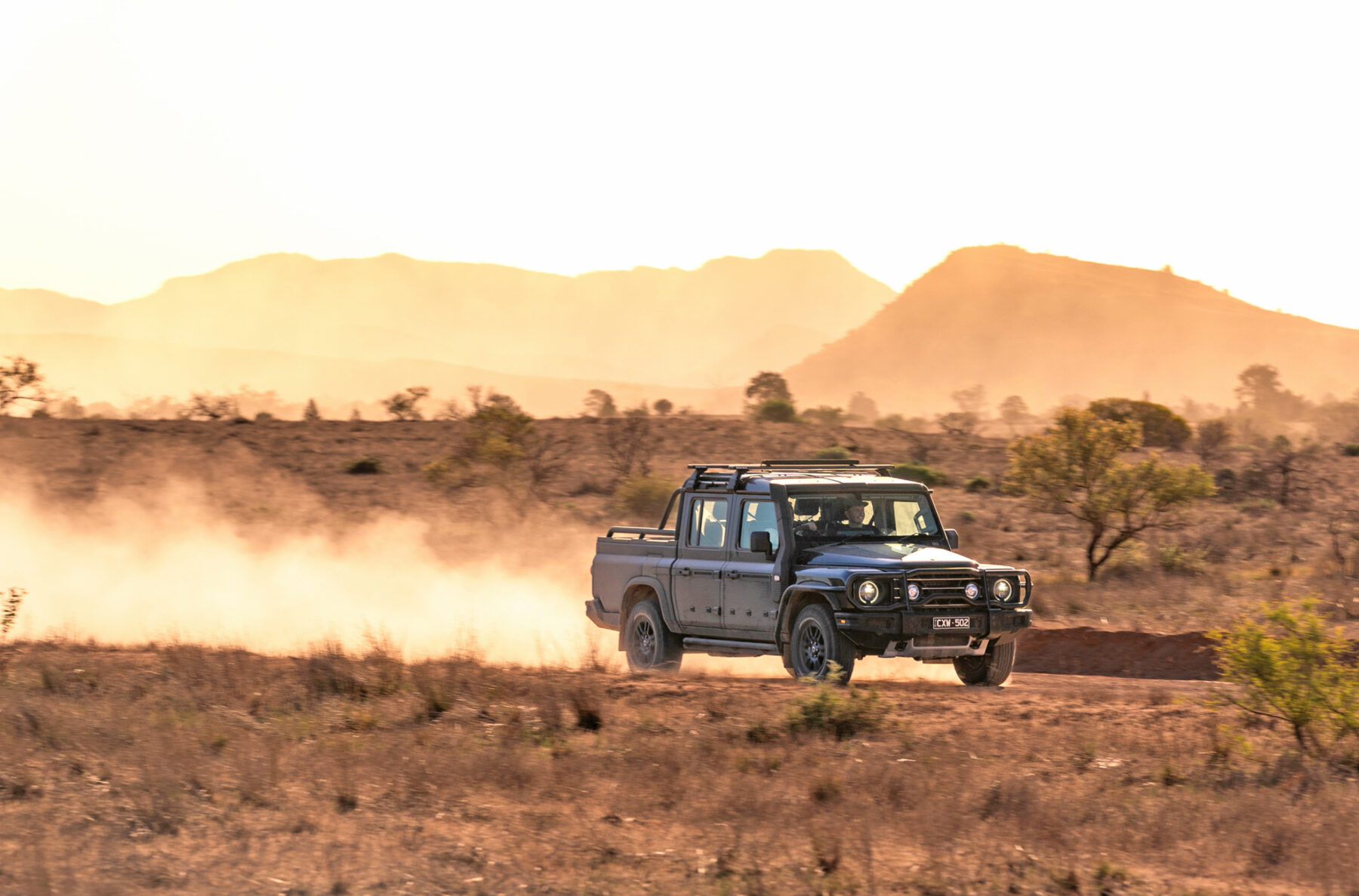
Despite its rugged underpinnings, the Quartermaster’s ride quality is impressively smooth. The suspension system, tuned for off-road capabilities, absorbs road irregularities effectively while maintaining the firmness required for stability and control. Sure, there’s a bit of body roll when cornering on the road, but no more than you’d expect of a high riding 4×4.
The test vehicles were fitted with optional BFGoodrich All-Terrain KO2 tyres. These Light Truck (LT) tyres offer a great compromise between on-road grip, acceptable noise levels, off-road traction and puncture resistance. You can opt for steel or alloy wheels in 17-inch or 18-inch sizes when configuring your Quartermaster. The base-spec tyres are Bridgestone Duelers in either a 265/70R17 or a 255/70R18, depending on what rim size you opt for; the BFG A/T KO2s are LT265/70R17 or LT255/70R18. The BFGs are an extra cost on all models except for the Trialmaster, on which they are standard fitment.

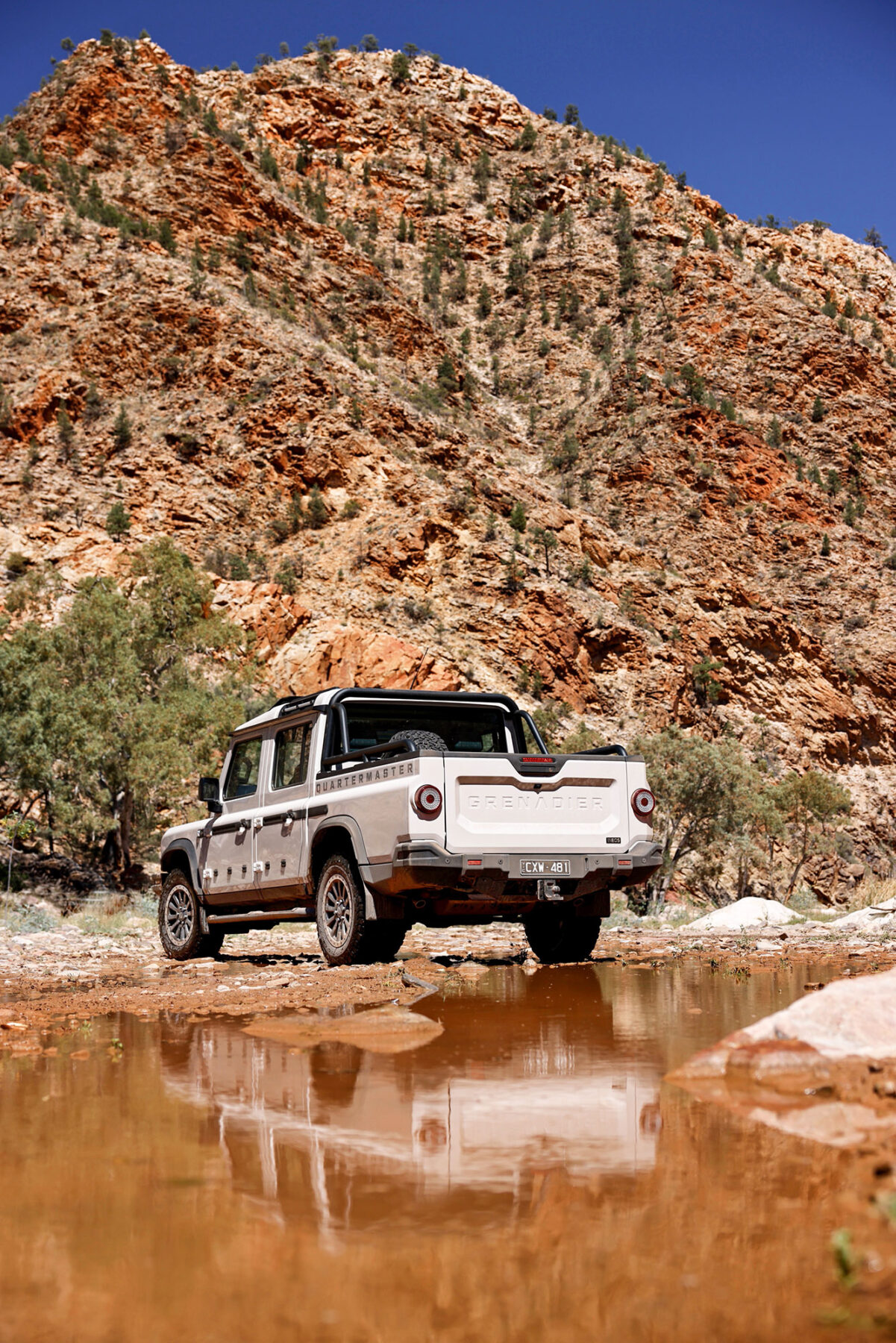
If you’re used to driving a modern vehicle with rack-and-pinion steering, you might feel as though the Quartermaster’s steering is vague just off-centre; Ineos says this can be attributed to the vehicle’s live-axle front end and its recirculating ball steering, but having driven plenty of Defenders and Toyota LandCruiser 70s over the years, both vehicles with similar axle, spring and steering packages, I reckon the Quartermaster’s steering is lacking in feel, particularly on the road. This could have something to do with the geometry of the front-end, or the tuning of the steering damper, if it’s the latter it would be easy to sort out. Once you get used to the steering feel, however, it’s not really an issue, and once you’re driving on gravel roads or off road, it’s in its element.
Unlike a lot of dual-cab utes on the market with disc (front)/drum (rear) brake setups, the Quartermaster has discs brakes all around, and brake feel – and performance – is more than up to the job of pulling up the weighty ute from high speeds, while the ABS calibration works well both on sealed roads and on the dirt. For the record, Ineos claims a top speed of 160km/h for both the petrol and diesel variants – I didn’t get the opportunity to test this claim, but I have no doubt it would be easily achievable.
One thing I wasn’t a fan of on the road was the centre-mounted instruments. I’d much prefer an instrument binnacle in front of the steering wheel where it’s in my line of sight rather than over to the left… and some of the information on the screen is too small to quickly read at a glance.
You can bring up a wealth of on- and off-road driving information on the 12.3-inch touchscreen, and it can also be used for Apple CarPlay and Android Auto phone connectivity. There’s also a centre console dial and buttons that can be used to navigate through various readouts and functions, as well as steering wheel controls. Trialmaster and Fieldmaster models are also equipped with a separate compass and altimeter.
That brings me to all the buttons and switches throughout the cabin, of which there are heaps! The dashboard design, inspired by aircraft cockpits, is polarising; while some may find the multitude of switches overwhelming, others will appreciate the tactile approach.
Off-road performance
I tackled some pretty serious off-road terrain on test, and I can assure you that the Quartermaster excels off-road when equipped with front and rear lockers and BFGoodrich A/T KO2 rubber. Both the petrol and diesel engines have plenty of low-rpm grunt and the low-range gearing is impressive. On this launch drive in the magnificent Flinders Ranges, most of the off-road driving consisted of station tracks and steep rocky climbs and descents, although we also had a play on some sand dunes on a private property.
On sand I would usually drop tyre pressures down to 25psi or less, but on this launch drive we left them at a road-going 36psi, so the Quartermaster really had its work cut out for it, yet it dealt with the soft conditions extremely well, thanks to an abundance of torque down low, plenty of power high in the rev range when required, and an electronics package (in off-road mode) that didn’t try to cut power when it sensed the vehicle slipping and sliding. Yep, this vehicle really is well engineered for off-road use.
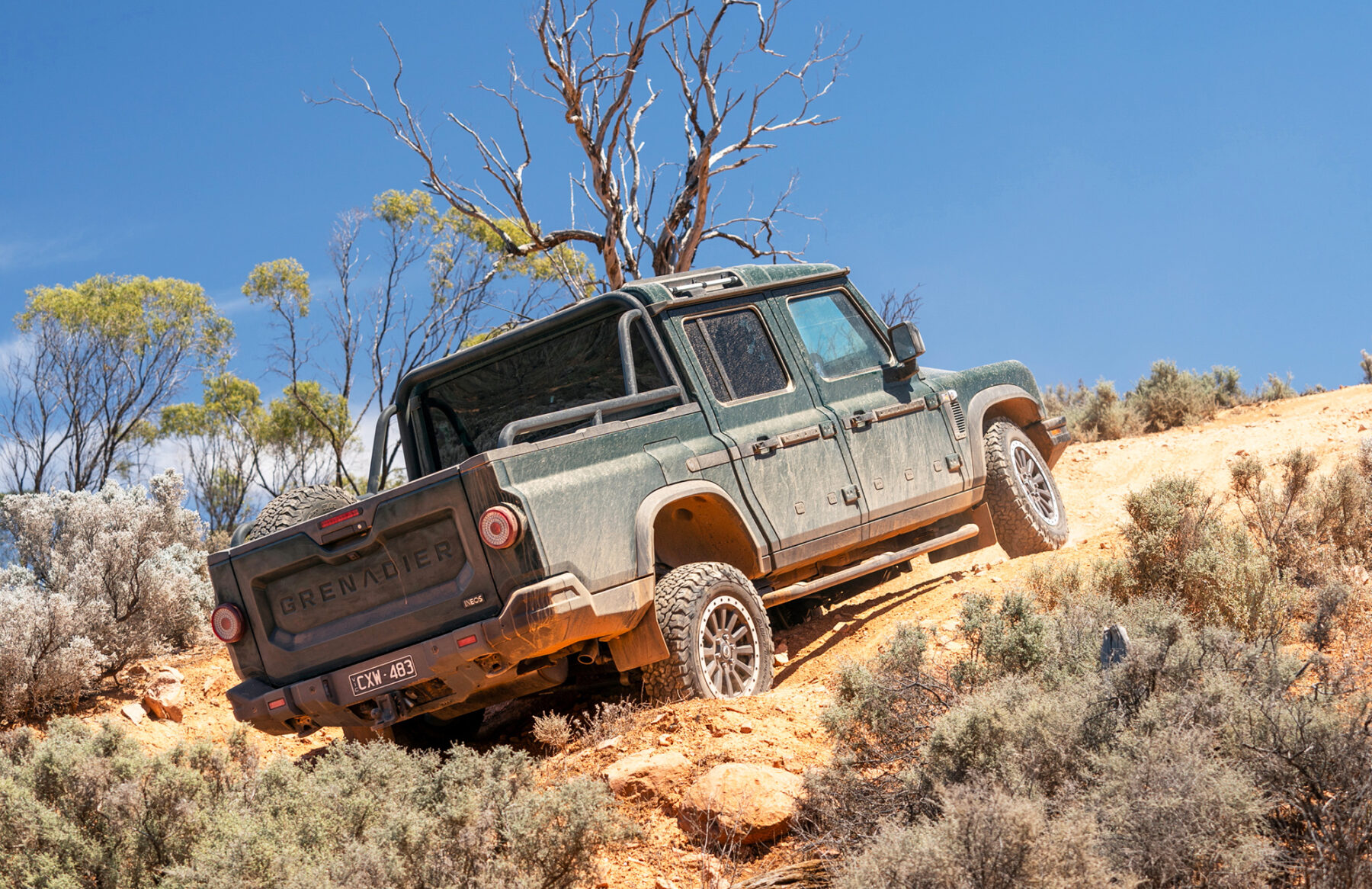
Ineos claims a ground clearance of 264mm for the Quartermaster, but I think there’s probably a bit less than that under the diffs. Having said that, the live axle design provides a constant ground clearance beneath the axles, so the hefty bash plate doesn’t hit terra firma every time the springs compress when driving off road as might be the case with a vehicle running an independent front suspension. There is decent underbody protection as standard, although the steering damper is located in front of the front axle and looks like it could be a bit vulnerable to damage in severe off-road terrain.
There are a few quirks in the cabin design that you notice when driving off road, the main one being that the transfer case is operated via a lever on the centre console, which you push to the left to engage the centre diff lock and then pull back to select low range, while the front and rear diff locks are engaged via buttons up on the roof panel. I reckon it would make more sense to have all of these off-road controls in close proximity, so they are easy to engage without taking your eyes off the track.
The standard bumper bar is a decent steel item, which should afford decent protection when driving off-road, and for those in need of more frontal protection Ineos offers an optional loop bar, which can also be had with side rails and either side steps or rock sliders to protect the sills of the vehicle. And if you get stuck off road, there are big recovery points front and rear, and an optional electric winch is also available to Sui the standard steel bumper bar.
Interior
The front Recaro seats are designed for long-haul comfort and provide good support and a reasonable level of adjustment. There is decent cabin width, and the flat shape of the windowsill is a comfy spot to rest your arm while driving. The centre console bin isn’t huge but is large enough to accommodate a couple of electronic devices, and there are USB-A and USB-C ports in there. The glovebox is small, but the front door-pockets are big.
Despite its longer wheelbase, rear-seat occupants aren’t afforded as much leg and foot room in the Quartermaster as their counterparts in the Grenadier wagon. In fact, the footwell is on the cramped side and the centre position is best left to to small kids; three adults would be a very tight squeeze across the back seat. The rear-seat backrest is quite upright, with no scope to adjust it for more rake. If you had a couple of tweens or smaller teenagers to lug around, rear-seat accommodation would be adequate; if you had two big teens or three kids, you’d seriously want to consider the Grenadier wagon over the Quartermaster ute.

If you have a lot of luggage and other cargo to carry around, the Quartermaster offers plenty of space in the tub, making it ideal for carrying tools, equipment or adventure gear. However, the placement of the spare tyre reduces available bed space, and because it sticks up higher than the side of the tub, it means you need a tailored tonneau cover. Of course, you could move the spare from its standard location, and I envisage many will opt otherwise secure against a headboard at the back of the vehicle’s cabin. For the record, Ineos says it didn’t mount the spare under the rear of the tub as it didn’t want to impinge on departure angle. Oh, and the tub has a durable Bedliner and decent luggage tie-down points
For those who want a customised rear setup, such as a tray or a canopy, the Quartermaster is available in a cab chassis variant, and this is likely to be a popular choice amongst both tradies and adventurers. Ineos has teamed up with Aussie tray manufacturer Norweld to develop a tray to suit the Quartermaster, and it’s a good-looking bit of kit. There’s also a Norweld canopy that can be tailored to suit specific trade or recreational uses.
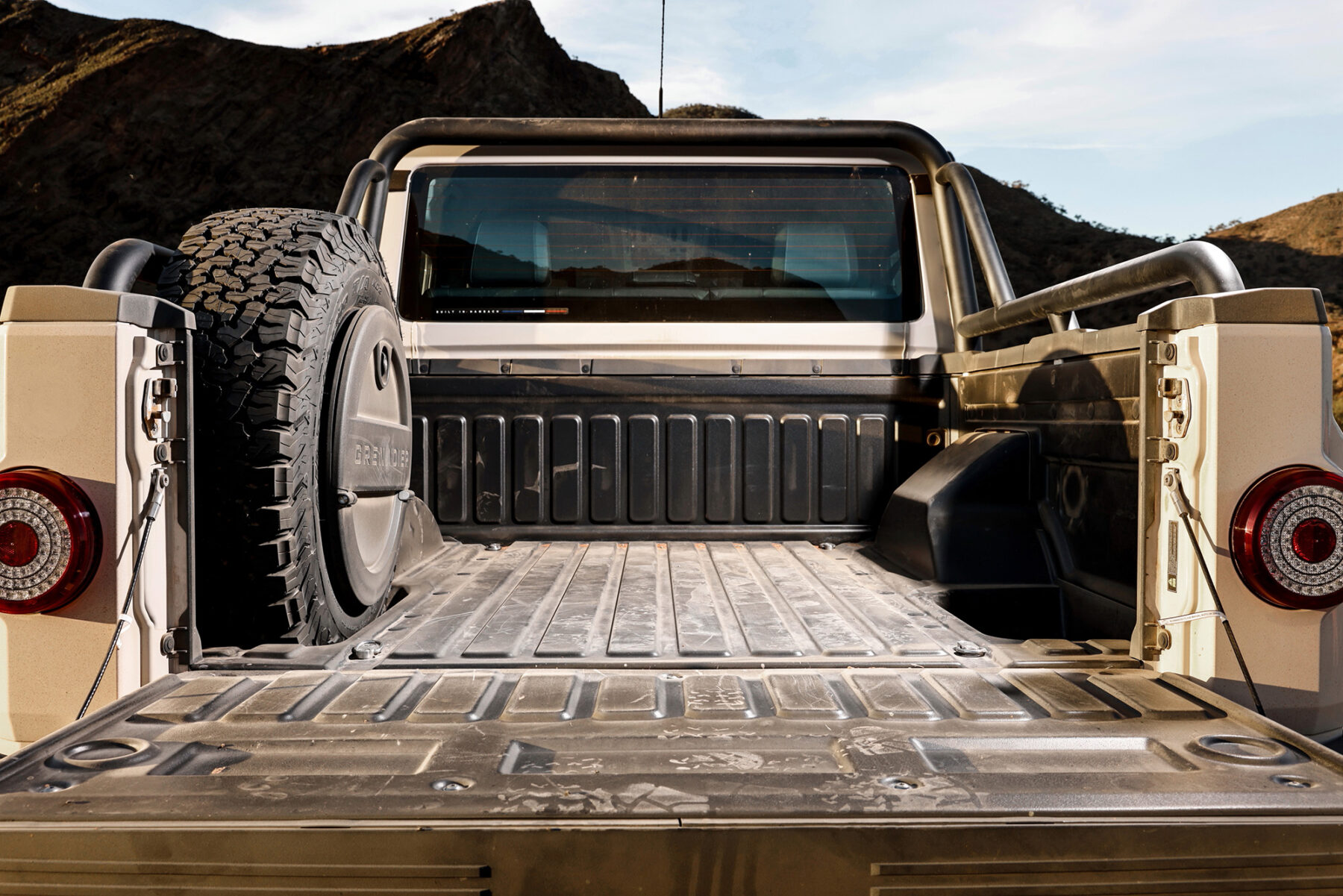
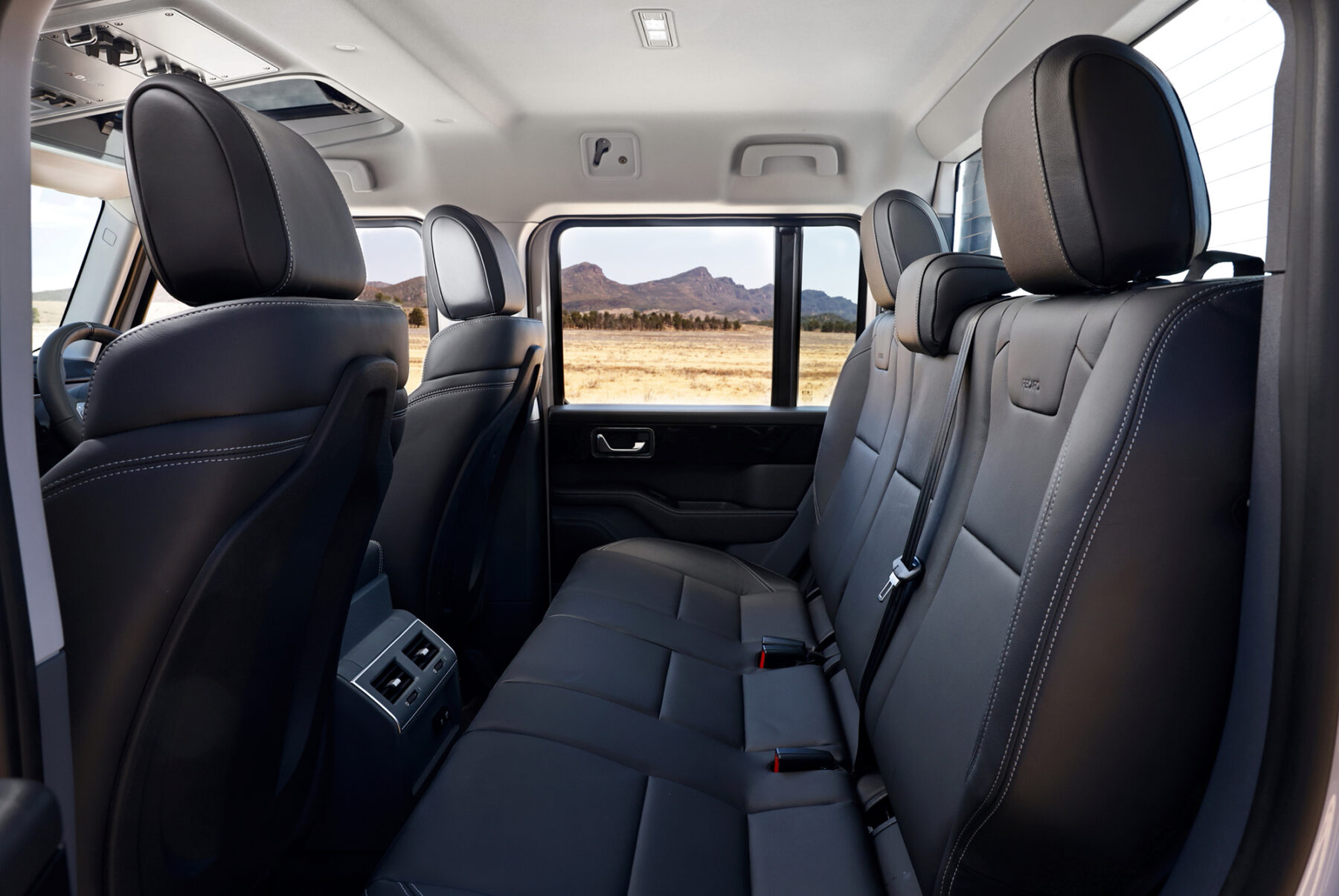
For gear that won’t fit in the tub, tray or canopy, Ineos has partnered with Aussie roof-rack specialist Rhino-Rack and roof bars and platforms can be fitted to the Quartermaster, along with all the associated accessories including awnings, jerry can holders, shovel and high-lift jack mounts, and sports equipment mounts for bikes, kayaks and the like.
Another nifty feature is the optional (standard on Trialmaster) exterior utility belt, which allows you to attach storage, protection or leisure equipment to the outside of the vehicle using quick-release tie-down rings. Of course, these are for off-road use only.
Payload capacity is 832kg for the diesel Quartermaster and 907kg for the petrol variant, while both offer the class-standard 3500kg maximum braked towing capacity and a 350kg tow ball load rating, which will please those who tow big caravans, boats or horse floats.
Safety
The Quartermaster is equipped with essential safety features, such as airbags and electronic stability control. However, it lacks advanced driver-assistance technologies found in many contemporary vehicles, such as lane-keeping assist or adaptive cruise control.
Standard safety kit includes front, side and curtain air bags, two ISOFIX points in the rear seat, tyre pressure monitoring system (TPMS), seatbelt reminder, uphill and downhill assist, and trailer stability assist.
The final word on the Ineos Grenadier Quartermaster
The Ineos Grenadier Quartermaster stands as a robust, purpose-built 4×4 with a clear focus on functionality and off-road performance. While it may lack some of the luxuries and high-tech safety features of mainstream SUVs, there is no doubt Ineos has built a dual-cab 4×4 ute that will suit adventurers and their families who want to get out there and explore the best Australia has to offer. And thanks to Ineos focus on partnering with proven Australian 4×4 accessory manufacturers, you can option up a Quartermaster with quality gear and remain covered by Ineos factory warranty.
The starting price for the Ineos Quartermaster is $102,000 plus on-road costs for the cab chassis variant but to that you will have to add the price of a tray or a canopy. The Quartermaster ute starts at $105k (+ORC), while the Fieldmaster and Trialmaster variants are $118k (+ORC). Go wild on the vehicle configurator on the Ineos website and you can spend many thousands more tailoring a Quartermaster.

Sure, the Quartermaster isn’t cheap, but it is quite unique on the market in that it’s way more refined than a Toyota LandCruiser 70 Cab Chassis and much heavier-duty than a Jeep Gladiator – the only other two dual-cab 4×4 Utes on the market with live axle, coil spring suspension front and rear.
My pick for remote area adventures? A diesel Quartermaster Trialmaster with 17-inch steel wheels, BFGoodrich All-Terrain KO2 tyres, standard front and rear diff locks, optional winch, loop bar, side rails and rock sliders, and Brown Davis auxiliary fuel tank. Now, where can I find a spare $130k?
What’s a Grenadier?
One year after the demise of the original Land Rover Defender in 2016, the Chairman of British chemical company Ineos, Sir Jim Ratcliffe, saw a need for a rugged, no-frills 4×4 that met modern standards of reliability and compliance.
Over discussions at The Grenadier pub in London with friends, Ratcliffe’s concept for a purpose-built off-roader took shape, inspiring the vehicle’s name. Soon after, INEOS Automotive Limited was founded, bringing together a team of automotive experts to turn this vision into reality with a fresh approach to 4X4 design and manufacturing.
Rather than start from scratch, Ineos Automotive scoured the world for what it considered to be the best suppliers of automotive components and brought these together to create the Grenadier, which is built in a state-of-the-art factory on the French/German border that was sold to INEOS by Mercedes-Benz.
As a result, the Grenadier is a vehicle that fuses British design with German engineering precision. Throughout its development, the team stayed true to Ratcliffe’s vision, creating a vehicle focused on exceptional off-road capability, durability, and reliability. Whether for work, adventure, or leisure, the Grenadier has been designed to support those who rely on their vehicle in any terrain across the globe.
Fact file
See Ineos Grenadier for more info and the latest pricing of the Quartermaster.




